“Dweghom society is riven through and through. Violent confrontations between members of these factions are a common sight, where long standing feuds can spark isolated incidents into full-fledged internecine warfare at a moment’s notice. One of the only things the leadership can agree on is that internal conflicts can be set aside in the face of an exterior enemy; as a result, most Dweghom hosts are in a state of perpetual conflict and ever ready to bring War to any brave, or foolish, enough to give them cause.”
The Dweghom are the Dwarf faction for conquest, the firstborn children of the horseman of War and quite probably the angriest dwarfs in any fantasy wargame. Aesthetically, the Dweghom will include elements familiar to enjoyers of both the Dwarfs and Chaos Dwarfs of Warhammer (doughty warriors, massive beards, but also a heavy emphasis on esoteric machinery, strange constructs and fire – so much fire), combined into one unique, angry package.
Dweghom are typically played as a combined arms army, combining extremely strong ranged and magical units with durable, dangerous melee elements. Dweghom are very tough and very dangerous, and are generally reckoned to be one of the best – if not the best – army in the game at time of writing.

Strengths:
- Outstanding infantry, monsters, brutes and ranged units.
- Flexible warbands with good mainstay choices to accommodate powerful restricted options.
- Powerful units in all weight classes – strong and varied, light, medium and heavy regiments.
- Excellent characters, with particularly powerful offensive spellcasting.
- Strong scenario presence with multiple good light regiments that can hold medium characters to allow the regiment to score backed up by powerful medium and heavy regiments to follow up.
…yeah, wow. They’re a pretty good faction!
Weaknesses:
- Generally expensive units and typically low to medium activation count.
- Very strong ranged damage is moderated by slightly lower range on the more powerful guns.
- Although the new models are very nice, many of their older mainstays are a little dated and challenging to assemble and rank up.
Fighting the Dweghom: Although this is a glowing recommendation, and Dweghom are by any measure an excellent faction to collect, it’s worth putting their strength in context. Dweghom are a good, well-rounded army with powerful troops, rules and abilities, but they aren’t overwhelmingly powerful. They don’t routinely dominate tourney results (although it’s very common to see a Dweghom player somewhere in any given podium lineup) and while they can feel a bit much the first time you run into them in a casual game, they can absolutely be fought and overcome. In this vein, if you’re a non-Dweghom player reading this article looking for tactical tips to counter your doughty adversaries, I’ve included some throughout the article – just look for the red sub-headings.
ARMY ABILITIES
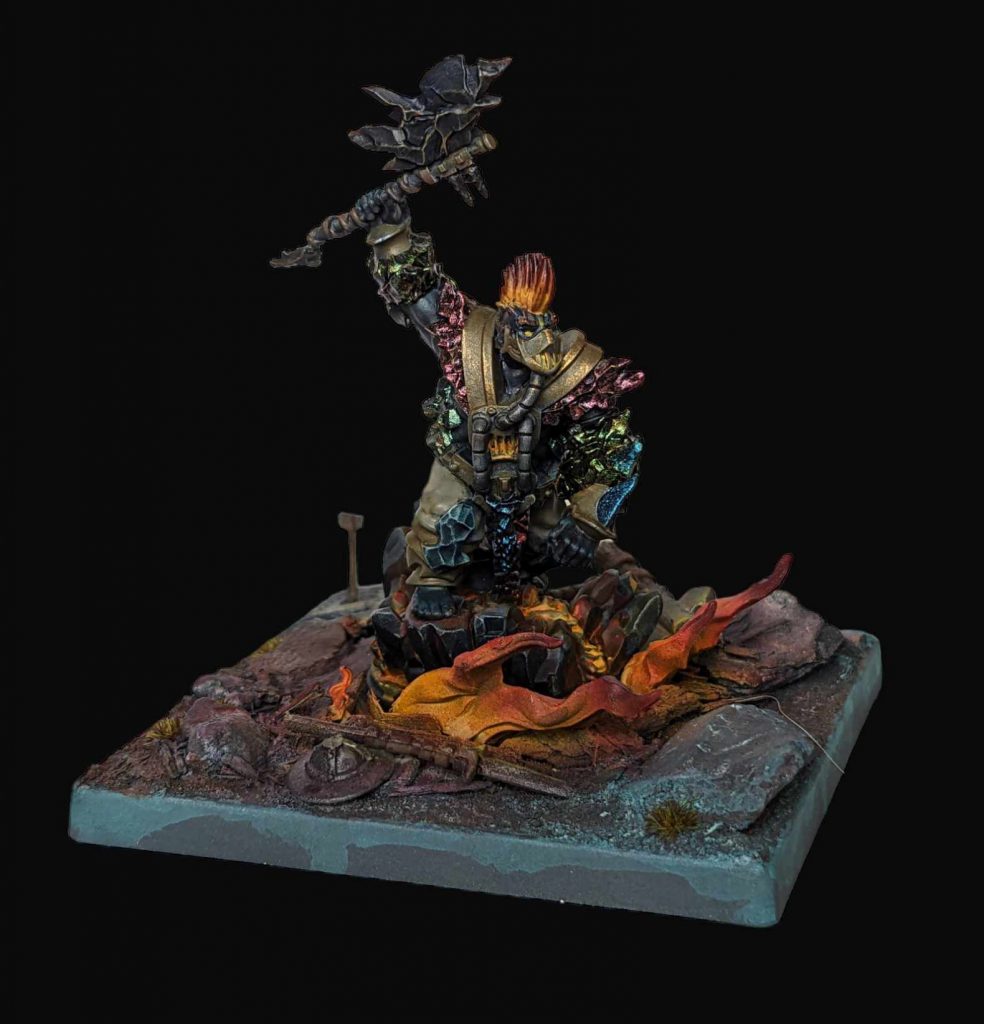
The Dweghom collectively have a selection of army-wide special rules. The first two, Firstborn Children of War and Pursuit of Aghm, are minor bonuses that apply to all Dweghom armies. The Dweghom Creed rules are more powerful, but apply only to armies with certain warbands.
Firstborn Children of War
All Dweghom regiments ignore enemy regiments for the purpose of determining reinforcement lines. A relatively simple rule that can be easy to forget, since Dweghom’s fastest unit is irregular (meaning as a faction they don’t tend to set aggressive reinforcement lines), and in any case they typically arrive from their own table edge to maintain mutually supporting formations. Still, in certain scenarios, and some game states, it can be very important to remember.
The Pursuit of Aghm
Dweghom Infantry Regiment command stands can declare duels! A fun and thematic ability, it’s rare to use it much in combat, since enemy characters can refuse without their regiment breaking, meaning you usually need to first break an enemy regiment to force the enemy to accept the challenge. This can be a cute way to score a kill or shatter an enemy regiment, but more often it’s a niche thematic rule. It’s a free additional action, though, so remember that you’ve got it when the opportunity arises.
The Dweghom Creeds – Ardent and Tempered
The final two army-wide special rules apply only if you have an Ardent Kerawegh, or Tempered Sorcerer or Steelshaper, as your general. This means a Hold Raegh doesn’t grant a Creed special rule, although he brings his own bonuses when selected as a warlord. Both these rules are meaningfully strong, but of the two, the Tempered Creed is overwhelmingly more popular and the focus of most Dweghom armies.
The Ardent Creed – all regiments in an army following the Ardent Creed perform a free rally or combat rally the first time they’re broken during the game. This is a powerful bonus, especially for particularly large regiments, which become effectively impossible to shatter in any meaningful way. The Ardent Kerawegh is also no slouch as a warlord, which should make this a quite attractive prospect. However, it’s very rare to see an army following this creed, because of how powerful the alternative is.
The Tempered Creed – overwhelmingly the most popular creed for Dweghom armies, even after a round of balance passes during the first update to the Conquest 2.0 release. An army following the tempered creed needs to be built around the Dweghom’s (excellent) spellcasters, and generates Elemental Potency Tokens every time a character successfully casts a spell.
When a friendly regiment within 8” of a Tempered Sorcerer or Steelshaper is performing a Defence, Clash or Morale roll, up to five of these tokens can be spent before rolling dice to convert any dice into an automatic success. Tokens can only be spent this way if success was already possible (i.e. they cannot be spent against an enemy attack that would reduce you to Defence and Evasion zero), but otherwise a Tempered Creed player can accumulate and spend these tokens without restriction.
This rule is a major contributor to the perception of Dweghom power. In any dice game, the ability to guarantee success without rolling is extremely powerful. The most common use case for elemental potency is on Defence rolls, to no-sell your opponent’s most powerful attack on a key unit. Although building up these tokens takes time, a Dweghom player will usually be able to generate enough tokens to stall out two or three powerful enemy attacks each game. This may not sound like much, but in practice can be decisive (and demoralising). Conquest is often a game about momentum and force concentration, and being able to sharply blunt the hardest swing your opponent takes at you is very powerful.
Playing against the Tempered Creed: When playing against a Dweghom player following the Tempered Creed (which in practice, at time of writing, is pretty much all Dweghom players), there are a few things you can do to help manage their access to the special rule:
- Firstly, you can try to deny them tokens to begin with, or at least limit how many they can generate. This can be done a few ways. The first and most obvious is to try to target and kill their spellcasters, but this will usually be easier said than done. However, two strategies that have worked well for me is to get a model capable of generating interference within range of their steelshapers and ardent kerewaghs (both of whom are the main passive source of tokens, but their failure rate tends to go up significantly if they’re interfered with), and avoiding the warlord fire sorcerer. Although the sorcerer’s range is quite high on some of his spells, if you can stay out of his range for even one turn that means two fewer tokens the Dweghom player has to spend over the game.
- Secondly, you need to be very judicious in how you approach engaging a Dweghom army. You cannot rely on throwing a single game-winning haymaker against a Dweghom player. Instead, you need to apply broad pressure on them to spend tokens early or at times they don’t want to. Armour-piercing ranged attacks or spells are excellent at this, or otherwise simply having a spread of decent melee units rather than a single all-powerful deathstar unit. A lot of the sense of power associated with the Tempered Creed comes from that first time your most powerful unit gets stalled out; if you have a diverse army with multiple threats, you’re much less vulnerable this this.
CHARACTERS
Ardent Kerawegh
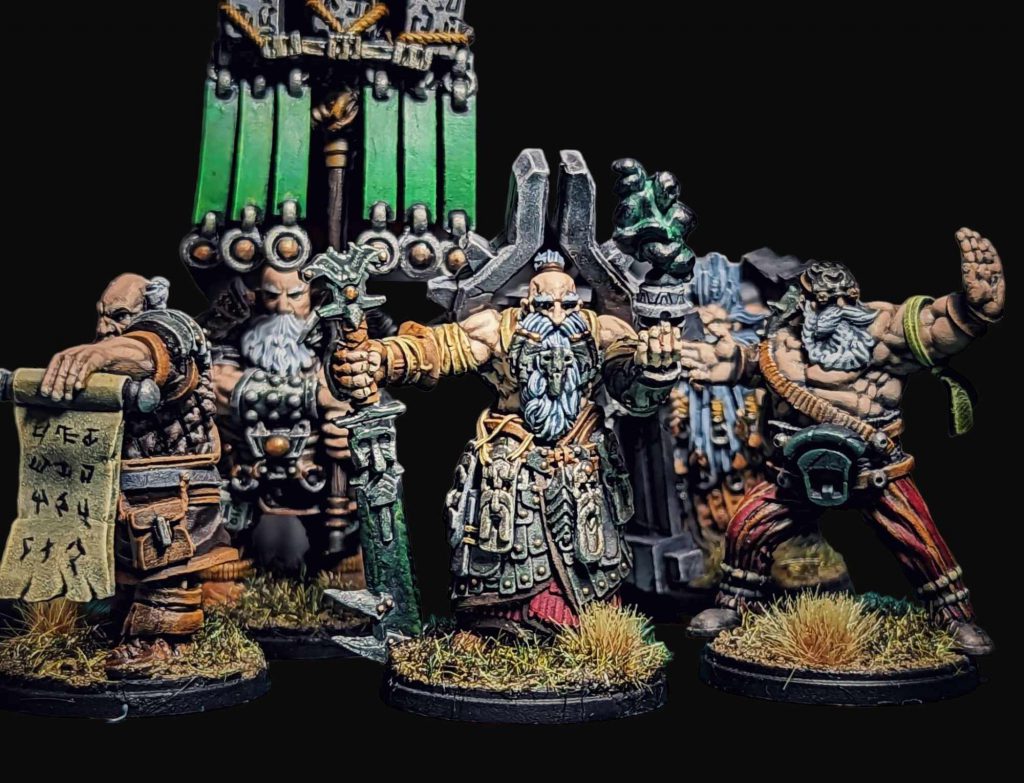
The only Priest character in Dweghom, the Ardent Kerawegh is a utility spellcaster with access to a relatively wide suite of items and a very wide retinue spread who is nevertheless often better off taken as a relatively cheap support character. Although it’s tempting to try to make use of their potentially incredibly powerful Dismay spell, their bread-and-butter use is casting Resolve just to generate some early Elemental Potency tokens, and potentially rally a unit later in the game (…and generate an Elemental Potency token).
Where the Ardent excels is not so much in their personal utility (which is fine, just not outstanding), but rather in the fact that they’re a medium character who both be embedded in and not slow down the highly effective light melee Flame Berserker regiment. Dweghom generally are one of the best armies in the game for fielding medium characters in light regiments for early scenario scoring, and the Ardent is a natural fit in a Flame Berserker regiment for this purpose.
Sample Loadout:
Ardent Kerawegh: Memory of Breath, Tactical 1. As noted above, this Ardent comes in at a nice cheap 100pts and slots into the biggest Flame Berserker regiment you can comfortably field, where he increases their aura of death to a scary [3], and all but guarantees they never take any resolve damage by combining their native resolve of 5 with the excellent Tactical 1 retinue.
Interestingly, you could also comfortably add this Ardent to unit of Hold Warriors with a Herald of Magma. This unit is almost as tough but less expensive than the Flame Berserkers, but the Kerawegh significantly increases the regiment’s Resolve, making them a very effective holding regiment. I wouldn’t be surprised to see this alternative use come up more when the excellent Magmaforged arrive.
Hold Raegh
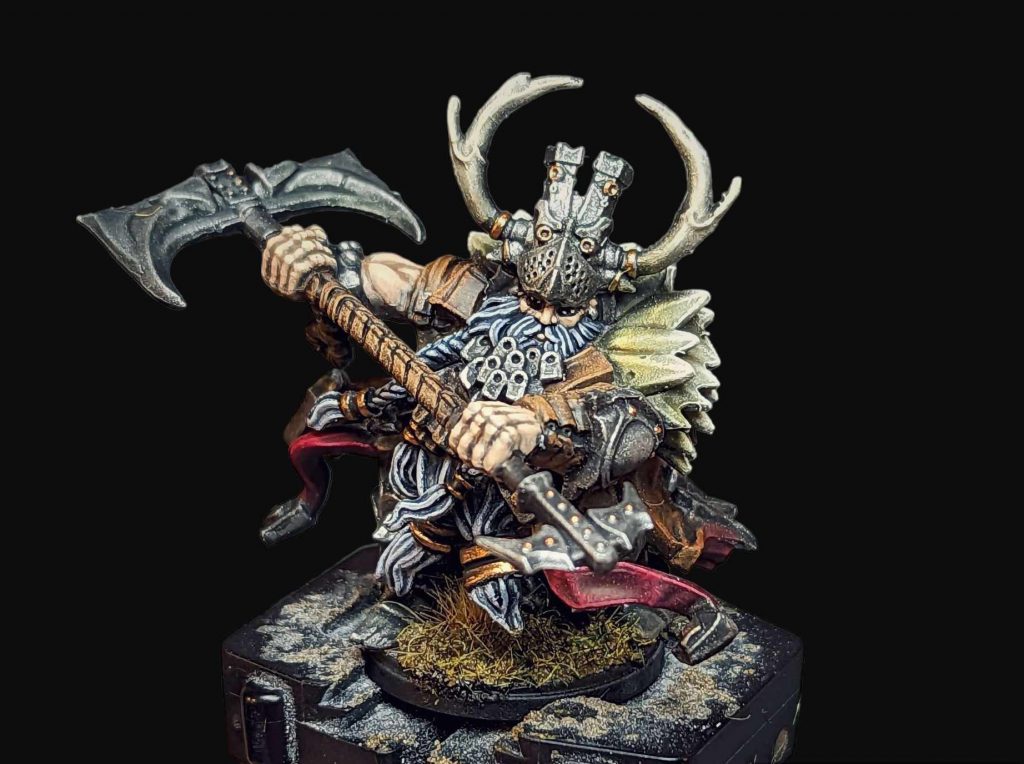
Kings of the Dweghom holds, the Hold Raegh is the only pure melee, non-spellcasting character in Dweghom. Potent melee combatants with high base attributes that can be further augmented by retinues and masteries, the Hold Raegh also has access to a warband with high-quality troops as both mainstays and restricted options.
Were a Hold Raegh excels is in adding that high quality melee potential to a Dweghom list otherwise based around spellcasting character warbands, to make the list a capable combined arms force rather than a pure gunline. Hold Thanes and Dragonslayers especially are excellent heavy units, which we’ll cover in greater depth below.
More controversial would be the use of a Raegh as your warlord. His supremacy ability is a straightforward and very effective +2 attack bonus to every command stand in your list, which can be combined with the Mnemancer Apprentices he unlocks and his Baptised in Combat mastery to really make the ability of Dweghom command stands to declare duels a scary prospect. This is a niche build compared to the power and utility of a list led by a Tempered, but it’s a very fun alternate way to play Dweghom from time to time.
Sample Loadout 2:
Hold Raegh: Champion’s Horns, Fuelled by the Furnace, Tactical 1. A simple but effective non-warlord Raegh to put in a unit of Thanes that you intend to outsize to four or five or five stands and want to do work with. Tactical 1 as always is a high value retinue for its very low cost, and with a high number of attacks, native Cleave (1) and relentless blows, this Raegh will add a lot of hits to whatever his Thanes accomplish.
Sample Loadout 2:
(Warlord) Hold Raegh: Champion’s Horns, Baptized in Combat, Combat 1, Combat 2, Combat 3. This is our warlord every-stand-can-duel-effectively version of the Raegh. Baptized in Combat requires Combat 3, but we’ll still be taking the very effective Champion’s Horns armour to make use of his high clash, although it could be replaced with the excellent Draegbrhud weapon for Cleave (3) if desired.
Tempered Sorcerer
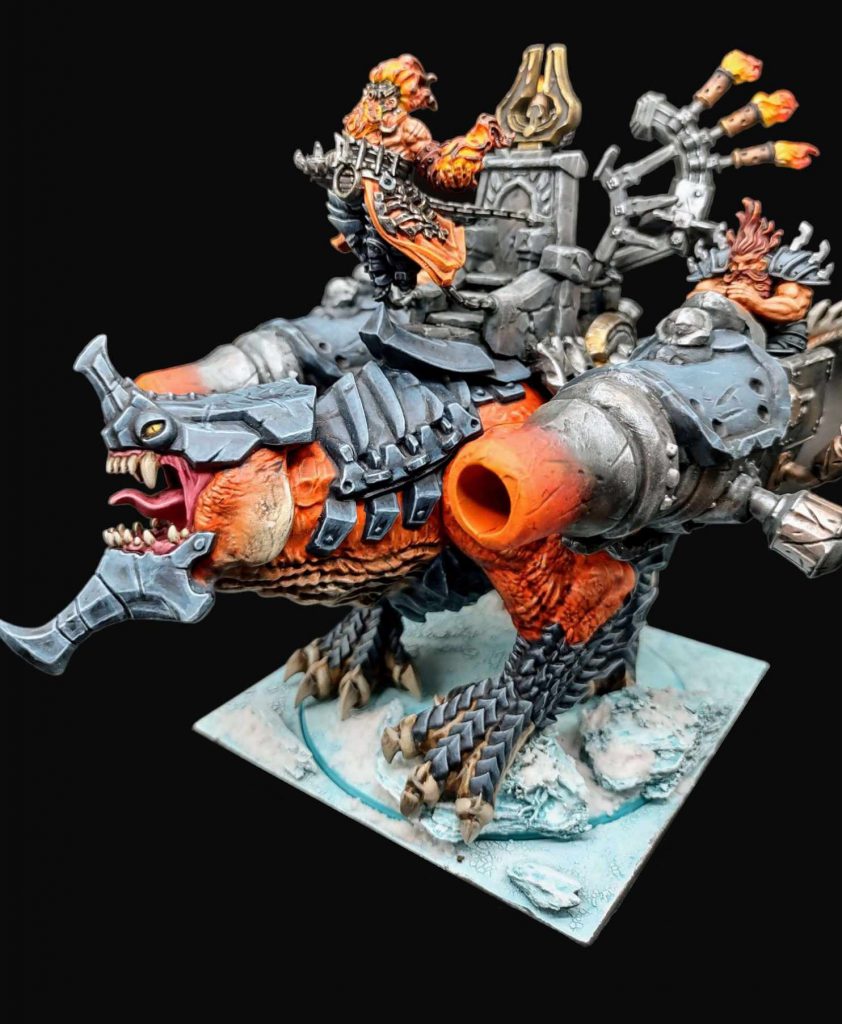
The most powerful spellcaster in Conquest if you measure power in terms of casualties inflicted on the enemy, the Tempered Sorcerer is the most common warlord in Dweghom and an easy go-to in any competition Dweghom list. In fact, take two. Really the hardest choices for your Tempered Sorcerers are how to kit them out and what spell school to take on your non-warlord one (because your Warlord Sorcerer is taking the Fire School).
Its hard to overstate how much damage a properly equipped warlord Tempered Sorcerer of the fire school can actually do. Even at longer ranges when they aren’t casting their devastating fire wall spell, the Fireball and Coruscation spells can easily annihilate smaller enemy units and terribly damage larger ones.
Your second Sorcerer, should you take two, offers more interesting choices about how to kit them out and even what spells to take. Because you aren’t casting two spells a turn with them, the Earth and Magma schools both offer an interesting selection of utility better suited to single casts in an activation, with some high notes being the Roots of Stone spell to immobilise an enemy, or the magmatic seep spell to neuter enemy cavalry. Both these schools also offer spells that can be cast without an enemy in targeting range, making them good for generating a few extra Elemental Potency tokens.
Sample Loadout:
(Warlord) Tempered Sorcerer [190]: Cthonic Flame, Fire School, Focused, Arcane 1, Arcane 2, Arcane 3. Want to laugh maniacally as your opponents sob into the remains of their shattered units? This is the spellcaster for you. Capable of inflicting a colossal number of hits on enemy regiments, the only downside to this sorcerer is that he’s public enemy number one and your opponent will try to kill him as quickly as possible. Fortunately for you, this typically means running to engage the unit of fireforged he’s bunkered up in, which means they’re in Fire Wall range and you can annihilate them. Fair and balanced.
If you need to save some points, Cthonic Flame can be cut entirely or exchanged for Graft of Fire, and you should still have plenty of damage coming out of this bad boy.
Playing against the Tempered Sorcerer: dealing with the damage output from a Tempered Sorcerer fire warlord, whether mounted on a hellbringer or on foot, is a big part of successfully engaging Dweghom. Mechanically, having good access to interference goes a huge way in blunting his damage (even if you’re a Wadruhn player, just paying 5pts for a Sacred Censer will save a lot of lives – if you’re Spires, I can’t help you here, sorry).
Once you’re actually on the battlefield, playing around a Sorcerer requires doing your best to manage range and line of sight. You won’t be able to keep him away for long, but even preventing one round of spellcasting might save you a lot of wounds. Once the lines are getting too close to avoid him, an extremely strong play is to engage his unit in the flank in a way that prevents him drawing line of sight to the flanking unit. Remember, a spellcaster whose unit is in melee can only target their spells that cause hits against the unit engaged with them, but these spells still require line of sight, and if you’re hitting his unit in the flank you can often stop him from casting at all thanks to this restriction.
Tempered Steelshaper

The utility Tempered, the Steelshaper tends to be a lot less flashy then their fire-slinging juniors but nevertheless fit extremely well into any Tempered Creed army.
There are a few things to note about them that aren’t obvious just from looking at the profile but add up to a very important character. Firstly, they’re a medium character (unlike the Sorcerer, who is light) and can therefore be added to a Hold Ballistae unit who they share 18” range with and allow to score. Secondly, like the Kerewagh, they have spells that don’t need an enemy target in range, which let them start generating Elemental Potency tokens from the first turn. And finally, they’re the only way to access Steelforged, which are… well, we’ll get to Steelforged below.
All of this adds up to a character that isn’t expensive, and isn’t flashy, but is highly useful. Depending on how many characters you can afford to pay for, there’s some argument for taking a second Steelshaper before you take your second Sorcerer, they’re that useful in the right list.
Sample Loadout:
Tempered Steelshaper: Arcane 1. Simple and effective. We’re not here for flashy effects. You can even cut the Arcane 1 if you really need to, but it goes a long way in helping the Steelshaper get his spells off reliably.
LIGHT REGIMENTS
Flame Berserkers
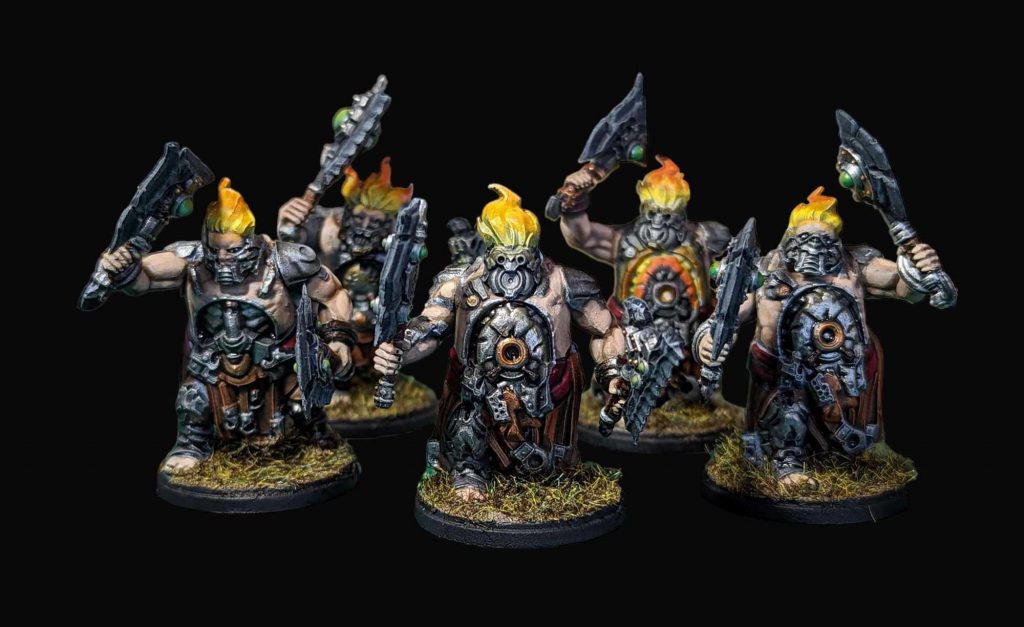
Although Dweghom are relatively light-on in terms of their access to light regiments, the ones they have are very capable. Flame Berserkers lead this march by being just about the most capable melee unit in the Light category for cost in the game, combining ok defence with a good number of wounds and outstanding resolve, relatively high speed, good clash, a whopping 6 attacks per stand and Aura of Death (2). This all comes at a cost, though; they aren’t a cheap unit (starting out at 180pts with a standard bearer, and costing 55pts per additional stand), which is a premium you’re paying precisely because of the unit’s weight category. In any other faction, Flame Berserkers would be a medium unit, but in Dweghom they’re on the table and scrapping early.
Only available in the Ardent Kerewagh regiment, Berserkers are almost always seen with the Kerewagh embedded in their regiment, which offers a little spellcasting support and bulks the unit out, but most important makes them able to score scenario zones.
When playing berserkers, it’s important not to over-extend them. Because they’re a relatively fast melee unit, there’s an urge to rush them toward the enemy, but their ideal place is just far enough forward that they’re scoring a zone while keeping any enemy who engages them out of it.
Fighting against Flame Berserkers: ranged pressure is highly effective against flame berserkers. Because they’re a very high resolve unit with only average defence, it counters them at a mechanical level, and it also pressures the Dweghom player to push the unit forward (to engage the unit harassing them). If they do, this can let you jump on them and deal with them before the main Dweghom force arrives.
Hold Ballistae
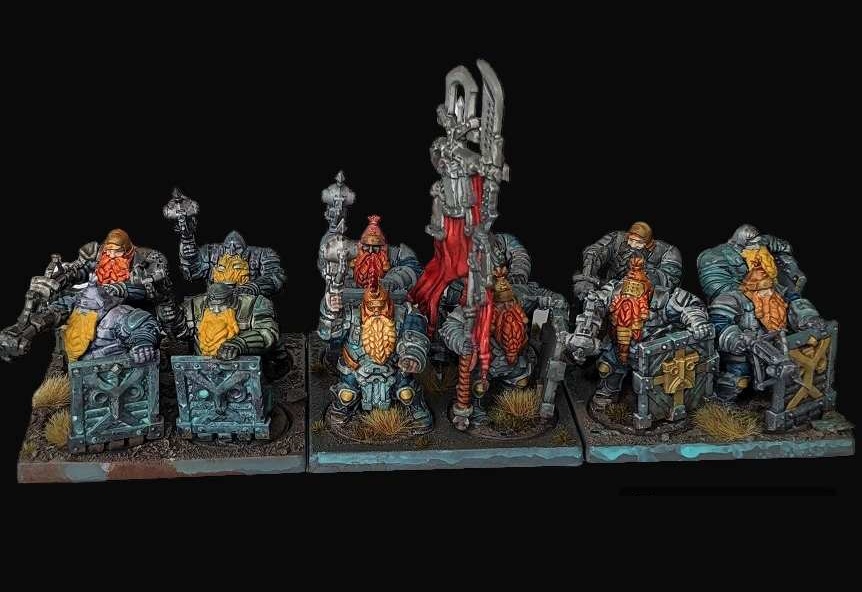
The only light Mainstay regiment available to Dweghom, Hold Ballistae are available in every warband and are an easy candidate for one of the most useful mainstay regiments in the game. Although they’re pricey compared to a comparable unit like Mercenary Crossbowmen, their wound count and especially their defence makes them capable enough in the counter-battery role and even able to survive a few rounds in melee against lighter enemy elements (although their Resolve 2 will eventually get the better of them in any protracted engagement).
They aren’t an outstanding unit, but they’re a cheap light mainstay with a very clear purpose. With good range, they can appear on the field early, survive fights with enemy ranged regiments, and then hang around in the late game providing fire support in the comfortable knowledge that the restricted regiments they unlocked will be doing the bulk of the real work.
Outside of the ‘good, cheap, light mainstay’ role, the ideal function for Hold Ballistae if you’re looking to get actual synergy from them is as a bunker for Tempered Steelshapers, who are just about tailor made to sit in a minimum Ballistae unit. A Steelshaper will increase the Ballistae unit’s firepower nicely and let them score backfield zones, letting you use the rest of your list to emphasise heavier melee units that can be trusted to assault enemy positions.
Handling Hold Ballistae: Ballistae don’t require any special counter, having basically average stats and doing basically average damage output. You still want to deal with them if possible, but prioritise engaging and destroying the ones with Steelshapers in them, as that will disrupt Dweghom token generation, and pressure them to spend tokens early to keep the unit alive. The only thing to avoid is trying to engage them in a ranged duel with weaker ranged units – the defence and wounds advantage Hold Ballistae enjoy over units like mercenary crossbows mean you want to get to them in melee rather than fight them at range if you don’t enjoy a qualitative advantage.
Inferno Automata
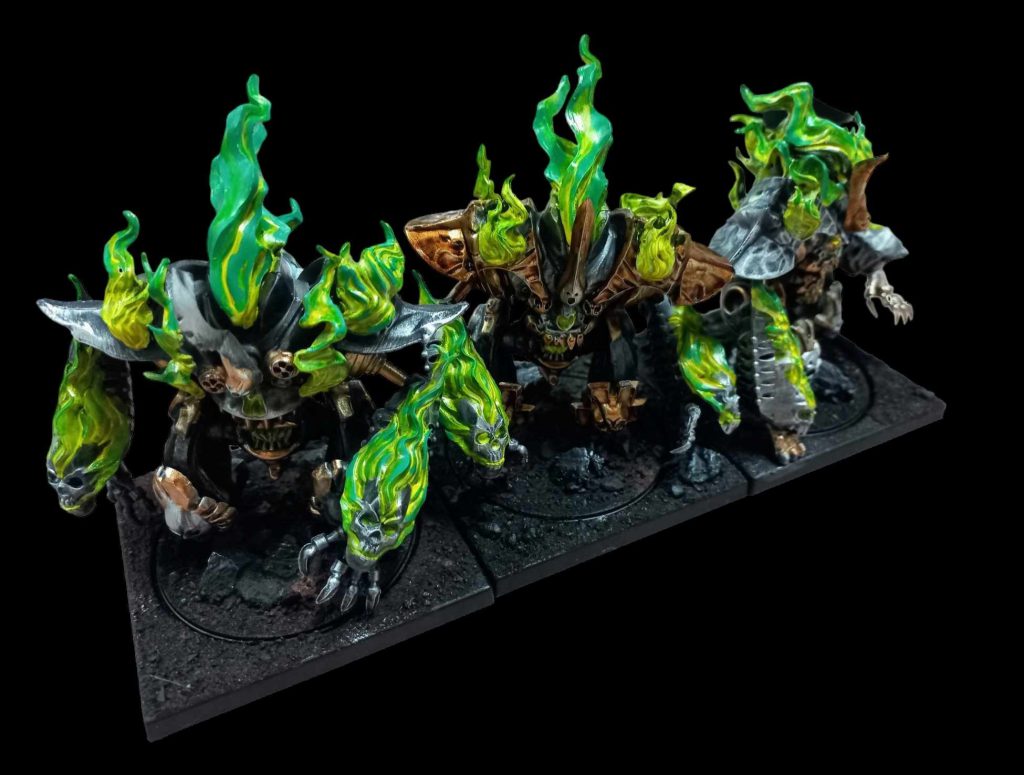
The third light unit in Dweghom, Inferno Automata are a restricted choice, only available in a single warband. Fortunately, that warband is the Tempered Sorcerer, so you’ll never struggle to include Inferno Automata in any list that you want to take them in. And you will want to take them – Inferno Automata make a liar of anyone who claims that Dweghom are slow, with one of the highest native threat ranges in the game by combining a whopping March 8 with Fluid Formation (which can be used to extend charge threat by rotating the corner of the regiment closer to the enemy you want to charge).
Although they’re a little more fragile than Flame Berserkers, and can’t accommodate a character, Inferno Automata are a terrifying unit to face, with ideal offensive output to annihilate enemy light regiments (which you can often deploy to counter thanks to how many light units Dweghom can comfortably take in a list) and generally pin back and enemy advance long enough to let Dweghom get a scenario lead and begin positioning their heavier units to hold the ground they’ve taken.
Inferno Automata can be effectively taken in units of three, but also excel by being reinforced up to 5 stands, which maximises their damage output and also lets them use Fluid Formation for larger threat range extensions. At least one unit is a fine fit in any list.
Engaging Inferno Automata: with the longest threat range of any unit in the game, dealing with Inferno Automata means accepting that you’re going to get punched first. Keep your units together, and setting up so that if the Automata hit any of your units in the front, other nearby unengaged units will be able to hit their flank. Inferno Automata are fast, tough and dangerous but their speed means they almost always push beyond the range of a Dweghom player to support them with elemental power tokens, so a flank charge will likely inflict a lot of damage through resolve and set you up for a future fight that stops them doing that much damage with aura of death.
MEDIUM REGIMENTS
Hold Warriors
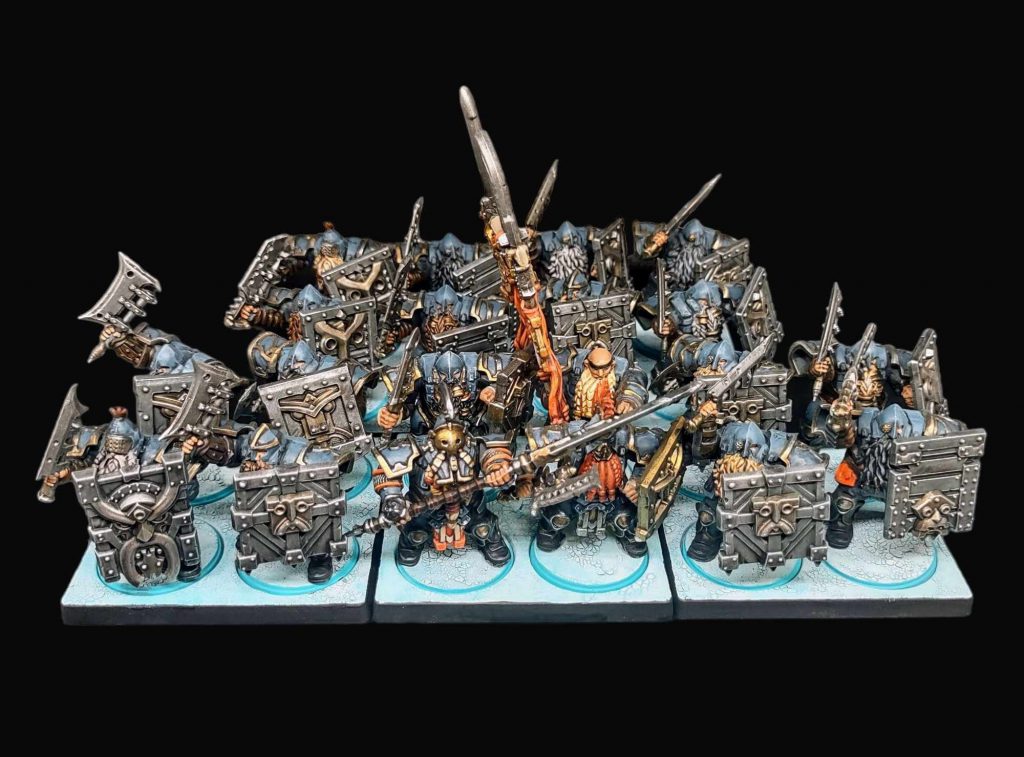
The medium, melee ‘Mainstay With Everyone’ unit, Hold Warriors are a very vanilla unit that are nevertheless quite nicely appointed for their cost. Although Ballistae are generally more common as mainstays thanks to their synergy with characters like Steelshapers and the general utility of light range units, Warriors are a good unit and have that singularly wonderful quality in common mainstay units of being able to be taken in multiple effective configurations.
This versatility comes off the back of a relatively cheap cost per additional stand, and the unique officers that can be added to a Warrior list, all four of which are genuinely useful additions and change how the unit functions. The Exemplar and Herald of Magma are my two personal favourites, depending on unit size, but all four officer options can be meaningful additions to the unit depending on what you need.
Although warriors won’t usually outperform a dedicated restricted unit in the same role, being common, medium and mainstay are qualities that make up the difference, and that flexibility lets Hold Warriors slot into lists that otherwise might not be able to accommodate a more specialised restricted unit. You can’t always fit a Hold Raegh and his Thanes in a list, for example, but you can find a warband slot for good old mainstay warriors, who’ll do some of the job at a cheaper cost. That’s a really nice capability to have access to, and one that some other factions can only look at with envy.
Fireforged
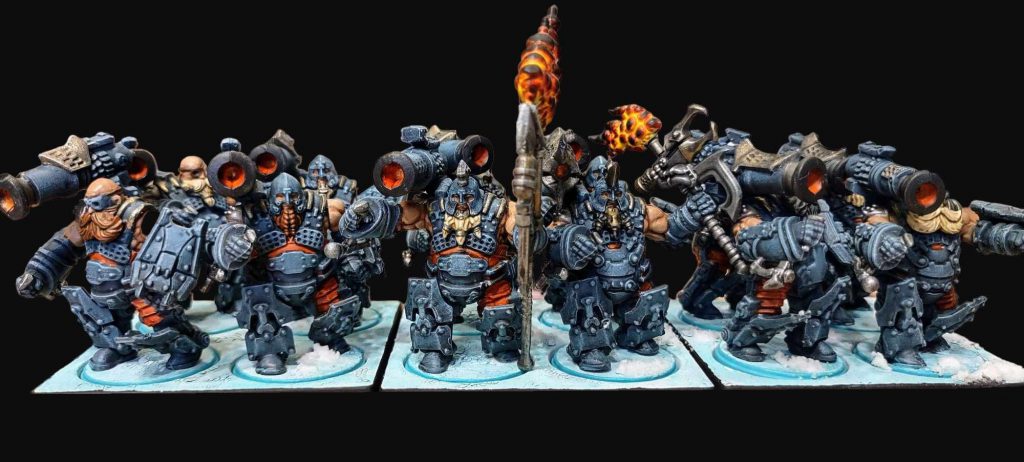
A mainstay regiment in Tempered Sorcerer and Steelshaper warbands (and a restricted regiment in Hold Raegh warbands), Fireforged are a simple, efficient, deadly unit. They’re wet noodles in melee, but they’re very durable, and their ranged attacks are extremely powerful. Their range is on the lower side at only 14”, but with Armor Piercing 2 and Barrage 4, they can put out a lot of damage if given the chance to aim and fire. For additional damage they can also be given a Flamecaster to give them the Torrential Fire rule, but given the challenges of moving them within 7”, I generally prefer to keep the unit cheap.
Although they can be taken in a few different warbands, Fireforged are the natural home for a Tempered Sorcerer warlord on foot. They’re a medium unit, so they can score, and they’re tough enough to provide him with a highly resilient bunker. For his part, the Sorcerer fixes their melee damage output, not because he’s necessarily any good in melee himself (he isn’t) but because he just annihilates anything that engages the unit with his spells, letting them get back to the business of shooting in short order.
Playing against Fireforged: dealing with Fireforged comes down to whether or not they have an embedded Sorcerer warlord. If they don’t, engaging them in the front with any unit will shut down their shooting, at which point they’re basically dealt with – the unit is very tough, but hit like wet noodles in melee. If they do have a sorcerer in the unit, this approach doesn’t work – you’re just going to get blown up by his spells. Instead, you want to kite the unit while you can, staying out of both gun- and spell-fire range, until you get an opportunity to hit them in the flank. Failing that, overwhelming force can do the trick, but if you have to hit them in the front try to do so with a unit that can fight on a narrow frontage (e.g. high support or cavalry using impact hits). This will prevent the sorcerer from getting especially effective hits with Fire Wall, which annihilates very wide units.
Hellbringer Drake

In almost all respects, a Hellbringer Drake functions as the monstrous equivalent of Fireforged, right down to its synergy with a Tempered Sorcerer. Although it’s more dangerous in melee, make no mistake – the whopping great cannons its packing are its raison d’etre.
Where the Hellbringer is significantly differentiated from the Fireforged are in an all-important extra 2” of range, and its size. As a size 3 monster, the Hellbringer can see and be seen over the heads of almost all other regiments (including, for example, Fireforged – which it might choose to hide behind).
Otherwise, the firepower of the two units is surprisingly comparable. The Hellbringer needs to arrive there via the slightly circuitous route of spending Overcharge tokens, but generally you’ll be aiming to always want to spend a minimum of one token per shot (to hit Armour Piercing 2, which you can’t exceed).
The big choice for a Hellbringer is generally whether to take it with a Sorcerer riding it, or alone – with the typical answer being to staple a sorcerer to it if at all possible. Because of how powerful a Sorcerer Warlord is and how much they benefit from a retinue (which is incompatible with riding a hellbringer), this usually means that the Hellbringer is ridden by your second, non-warlord sorcerer, but plenty of successful lists forsake the retinue in order to mount the warlord on the Size 3 hellbringer to take maximum advantage of the line of sight it offers.
Surviving the Hellbringer: a Hellbringer can be treated much the same way as Fireforged, including all the same tips for dealing with it if a sorcerer is riding it. Unlike Fireforged, though, a Hellbringer is fine target for any counter-battery fire your army might have. Compared to most Dweghom units, a Hellbringer is relatively fragile, with fewer wounds and lower defence than a unit of Fireforged, for example. If you do try to bring it down at range, though, make sure to commit to the kill – a Hellbringer is just as effective at one wound remaining as fourteen, so be sure to finish what you’ve started.
Initiates
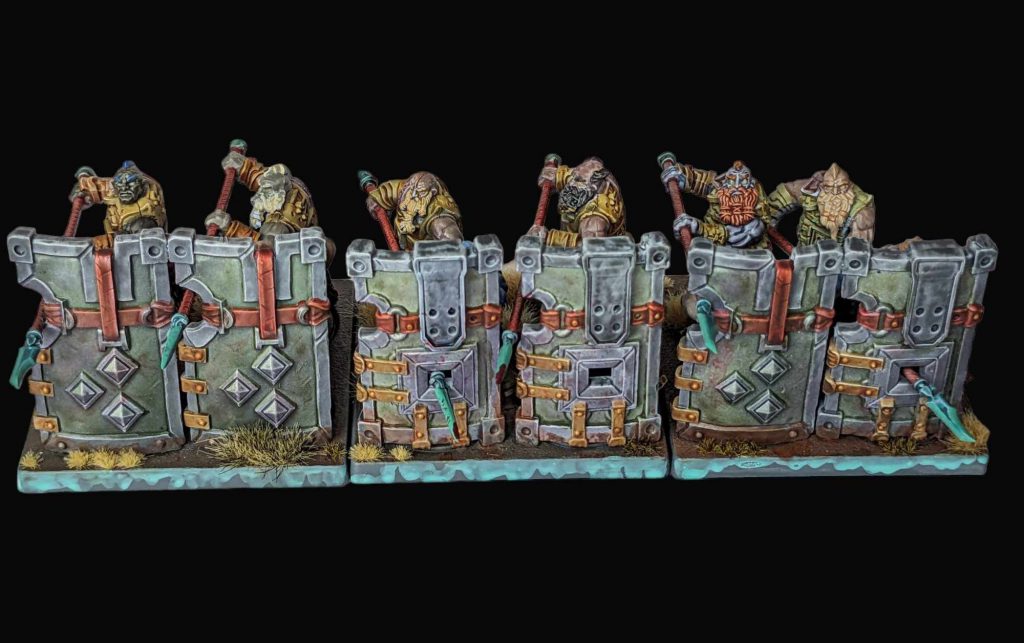
A medium mainstay regiment available to Ardent Kerewagh and Hold Raegh warbands, Initiates are a very defensively focused regiment, with a mere 3 attacks per stand in exchange for higher resolve, defence and iron discipline in comparison to the more generalist Hold Warrior regiment.
Although this trade-off isn’t unreasonable, Initiates are ultimately one of the very few lacklustre units in the Dweghom roster. More than anything, this is the curse of the Support (2) regiment, which is a rule that usually ends up being both expensive and low impact when combined with medium mainstay units making a low volume of low clash attacks with no special rules.
Usually, for not that many more points, Initiates could be something like Thanes, which are also a mainstay unit for the Raegh, and are excellent, well-rounded melee infantry. Thanes are heavy, though, and while Dweghom are blessed with probably the best suite of high-quality medium options in the game, if you wanted just one more medium unit in a list in the form of Iniates, the best bet is to tool a Hold Raegh up to the gills and stick him in the regiment. You’ll be able to get them on the board a little earlier and really shove, relying on your Iron Resolve rule to make it safer to push them aggressively forward and make use of the earlier game presence.
Where Initiates really do come into their own, and make sense of the entire kit, is in a different game entirely. Their aesthetically pleasing pike and spear formation is much better implemented in Conquest: First Blood. So if you own a unit – make sure not to glue them to their regiment stands, so you can use them in their intended role!
Wardens
Available only in the Ardent Kerawegh warband as a medium mainstay choice, wardens are the most offensively oriented medium melee unit in dweghom, packing an impressive 6 clash 3 attacks with Cleave 1, for a somewhat pricey but ultimately reasonable 180pts for a base unit and 55pts per additional stand.
For a mainstay unit, Wardens are surprisingly pure of purpose, and their offensive output is very high for a unit you can comfortably take in minimum size to unlock flame berserkers for the Ardent to sit in. They’re not easy to perish, either – there are many tougher Dweghom units, but five wounds, Defence 3 Resolve 4 is no slouch. Really, the only thing holding Wardens back is just that they only appear in a single warband, which makes them rarer than they might otherwise be just by sheer dint of being difficult to access as easily as many other units. But if you are taking an Ardent, they’re a fine choice as a simple standalone regiment if you’re so inclined.
Magmaforged
The final regiment in the Ardent warband, Magmaforged are an unreleased kit, but will likely be released as part of a dual kit alongside Stoneforged in the Tempered warbands. Magmaforged are a grindy, passive damage regiment, with very strong defensive attributes and the combination of both Aura of Death and Lethal Demise to deal a continuous of damage to enemy units engaged with them.
At 200pts, Magmaforged aren’t cheap, but they’re also a very durable medium unit, with their only downside being they struggle significantly if forced to fight a unit with particularly high Defence. With no cleave, they rely on scoring lots and lots of hits to break through enemy regiments, making them more of a ‘punch down’ kind of unit – which is ok to be, when you’re medium, but something to bear in mind when bringing them onto the table.
Steelforged
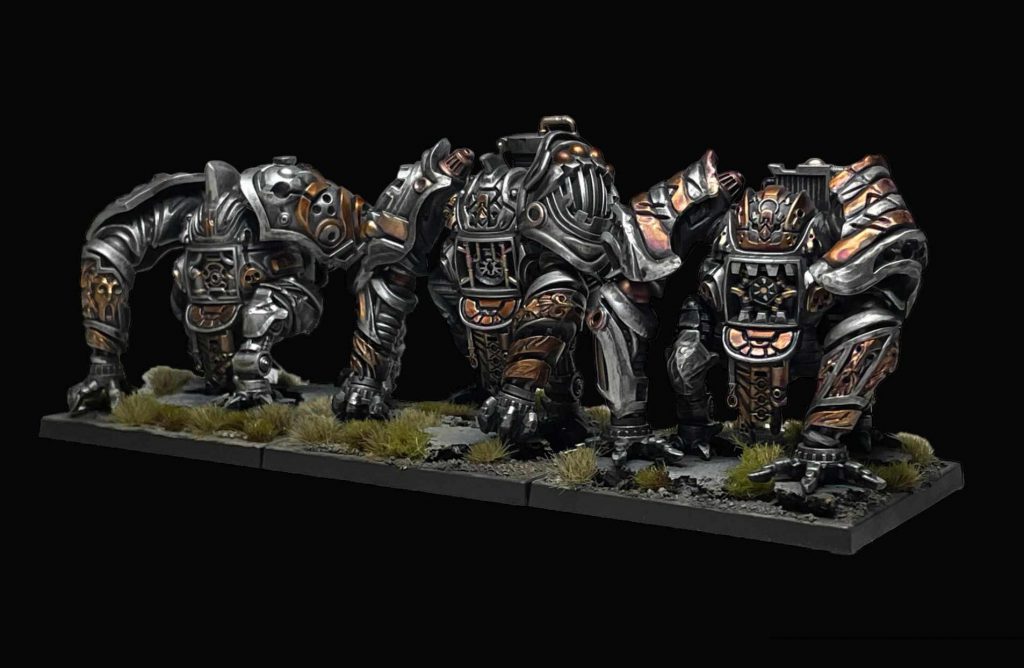
Strong contenders for best regiment in the entire game, at cursory inspection any sensible player could be forgiven for thinking that Steelforged were a heavy regiment that wandered onto the board a turn early by accident. Frankly, Steelforged are pushing right up against the boundary of units that are a potential balance issue game designers can run into not when a unit isn’t working as intended, or when an interaction or synergy has been missed during testing, but instead are consistent high performers just because Number Very Big. Nothing Steelforged do is difficult to understand: they’re reasonably fast, insanely durable, and put out a lot of highly accurate cleave 1 attacks. Their Numbers, in short, are Very Big. Very Big Numbers are good!
This kind of raw numeric strength makes it difficult to offer much nuance in the way of analysis of the Steelforged, because anything else I say could be replaced by the Will Smith gesturing meme toward an extract of their stat block. The only mildly confusing thing about them is their Flux-Powered draw event, but I can save you some time here at least – if in doubt, pick +2 Clash. Picking +2 Clash is better than picking +2 Attacks in every circumstance except when you’re already in melee and performing an Inspire + Clash action, when technically speaking picking +2 Attacks is better by a fraction of a fraction of a percent (which is to say, you could still safely pick +2 Clash without really worrying about whether you were stuffing up). It’s a slightly quirky design decision that the draw event billed as giving players a choice that doesn’t actually offer a choice and is instead a math puzzle with a clear answer, so I wouldn’t be surprised to see this change at some point down the line.
That minor quibble aside, you will never, ever go wrong with a unit of Steelforged and given their relatively attractive price point in a high utility warband, every Dweghom player should own a regiment provided they also own a Steelshaper. They’re incredible, consistent performers, and look awesome, really leaning into the mechanical side of the Dweghom in a way that’s totally unique and an example of how good Conquest can look when Para Bellum do their own aesthetic thing. Frankly, their resemblance to Kinder Surprise Eggs would make me worry they’d be banned for sale in the US, except for the fact that these guys are absolute guns.
Cracking Steelforged: more than any other regiment in Dweghom, Steelforged are a regiment that require a mechanical counter. There’s no two ways about it, you’re going to need cleave, armour piercing, brutal impact, or smite, and lots of it. If you can, get hardened into the picture too. Steelforged are just a massive pile of really good stats, and the way to deal with that is with your own, more specialised stats. Steel Legion, Incarnate Sentinels, Varangian Guard and similar all fight Steelforged on equal footing (and since these are all heavy regiments, you can hold them until you know where the Steelforged are committed). And if you’re playing Wadruhn, setting up a tier 2 Death chant will let any of your units make a dent in Steelforged, thanks to the power of Flawless Strikes.
HEAVY REGIMENTS
Dragonslayers
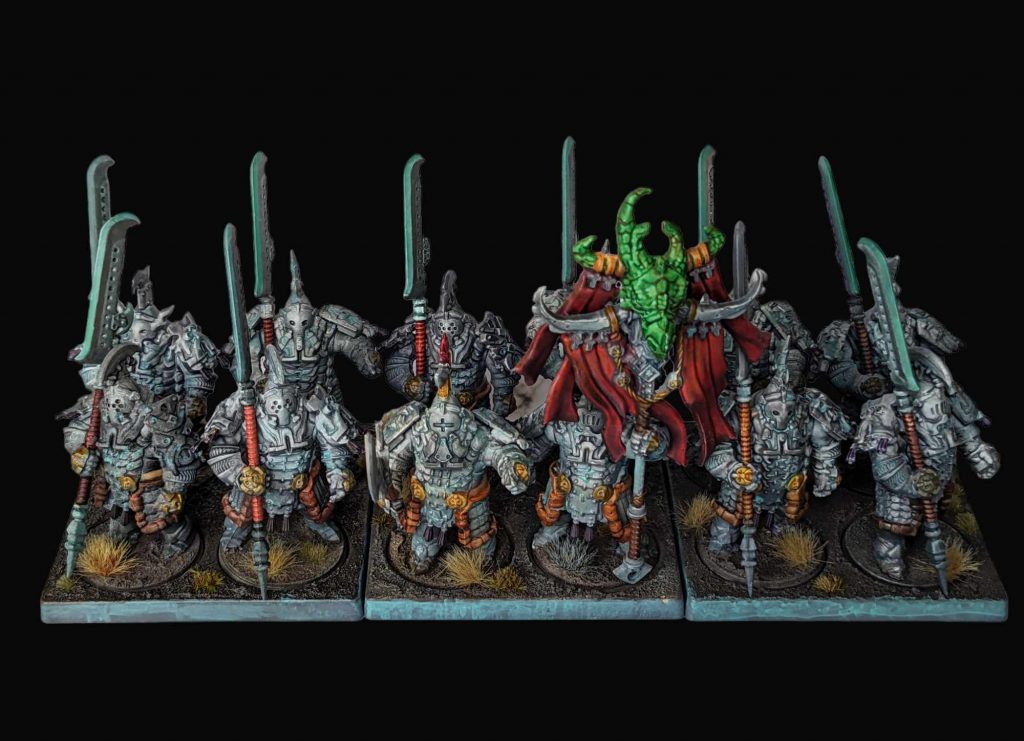
Dragonslayers are a tough regiment to evaluate objectively, because the weight of history presses down on them so heavily. Back in Conquest 1.5, they were a rare 2-wounds-per-model Infantry regiment, giving them a whopping 8 wounds per stand, and they were rightly regarded as one of the toughest, scariest units in the game.
Today, that reputation has been brought back down to earth, but they’re still a very good unit, albeit more specialised in this day and age. Six wounds with Defence 3 Resolve 4 is still pretty tough thanks to Hardened 2 rendering them nearly immune to rules like Cleave, Brutal Impact and Armour Piercing, but they’re quite vulnerable to high volume attacks and as such want to avoid fighting enemy chaff and focus exclusively on the biggest, baddest enemy units on the battlefield.
If you can engineer this matchup for them, they come into their own. Very few elite regiments at the same price point will win out over Dragonslayers.
Dealing with Dragonslayers: these lads are best dealt with by feeding them chaff. Dragonslayers will kill force grown drones and militia at almost the same rate they kill Brute Drones and Crimson Tower Knights, so tie them down and throw lots of bog standard no special rule melee attacks into them. If you can engineer it, Aura of Death and Lethal Demise are both fantastic rules to hit Dragonslayers with – a unit like Stryx or Cultists will cost the Dragonslayers dearly and probable inflict more points worth of casualties on the Dragonslayers than they cost in the first place.
Hold Thanes
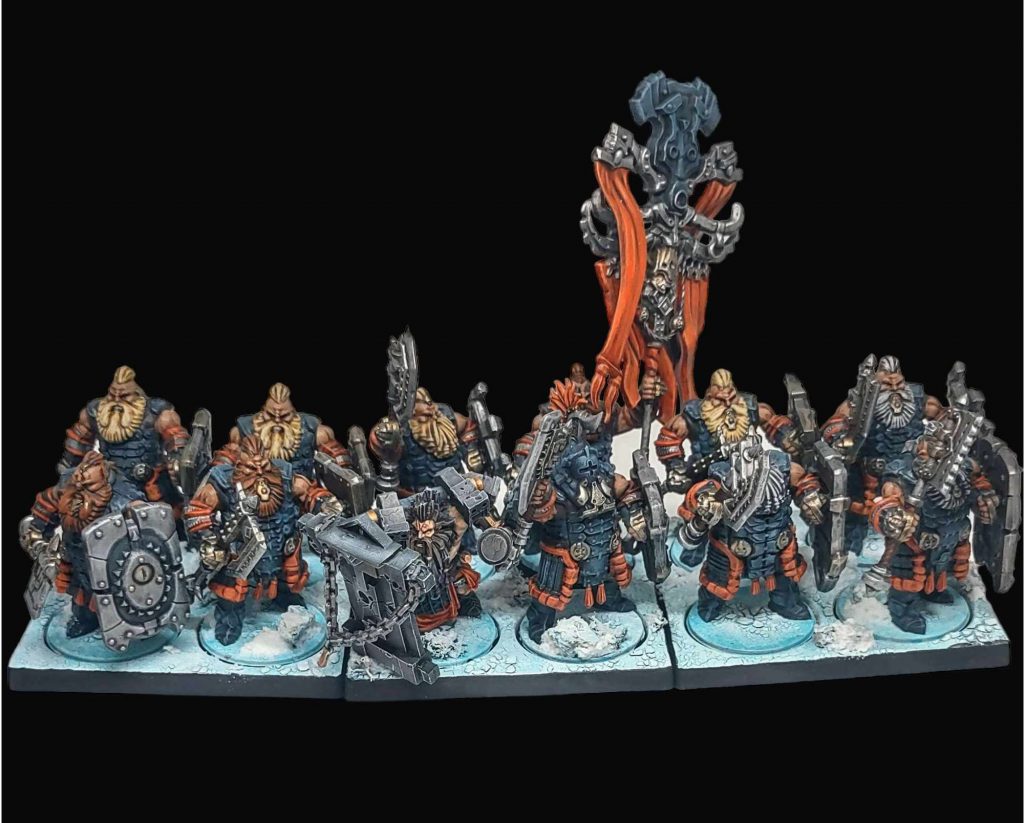
Another regiment unique to the Hold Raegh, Thanes are the generalist mirror to the specialist Dragonslayers, the two regiments pair extremely naturally thanks to being in the same warband and being mainstay and restricted respectively.
Thanes are consummately well-rounded; they’re very tough, punch on well, and have very versatile configuration options thanks to sharing most of the same Officer options as the baseline Hold Warrior regiments. They’re a natural home for the Hold Raegh himself, and can always be trusted to hold ground and carry a fight. Where you want to keep Dragonslayers for fighting the toughest enemy stuff, you can rely on Thanes to effectively fight everything else, generally doing their best work fighting the 90% of the enemy army that isn’t packing very high cleave or armour piercing attacks (which can be left to the Dragonslayers to handle).
There’s not much more to be said; Thanes are good, reliable, and mainstay, and the only thing about them that remotely passes as far as criticism goes is that they’re not Steelforged. But Steelforged aren’t mainstay and don’t unlock Dragonslayers, so shut up.
Threatening Thanes: in stark contrast to Dragonslayers, Thanes are a unit you’ll want to try to line up a good fight against with a properly elite regiment. Don’t half-ass your engagement here, Cleave 1 isn’t going to do it – you want good high cleave values, or a rule that bypasses Hardened. Deadly Blades and Linebreaker especially are both well suited to bringing Thanes down. A unit like Thunder Riders is their worst nightmare!
If you don’t find yourself with the force available to bring Thanes down, then your fall-back plan is to pin them and hit them in the flank. Although you probably won’t do much resolve damage if a Raegh is in the unit, bypassing their shields will help a lot, and might swing the fight in your favour.
Ironclad Drake
A melee monster in every sense of the word, the Ironclad Drake is the heavy melee equivalent of the medium ranged Hellbringer Drake. The Ironclad is just about the perfect brawler melee monster, paying for no special rules it doesn’t need, with high damage output, cleave 2 and terror 2 (making it the only source of terror in Dweghom outside the Hellbringer, which you don’t really want in melee) and solidly durable. It even has Unstoppable, which combined with its March 7 makes it the second-fastest unit in Dweghom after the ridiculously zippy Inferno Automata.
Pound for pound, there’s not much that outclasses an Ironclad in terms of being a well-appointed high-quality punchy boi. The only thing holding it back in any sense is that it’s unique to the Hold Raegh warband, which is full of well-appointed high-quality punchy bois, and finding a slot for it means either cutting Dragonslayers (who are tougher and more dangerous, but much slower and degrade as they lose stands) or including a second Mainstay regiment. The Mainstays in the Raegh warband are good enough that this isn’t much of a sacrifice, though, so expect to see Ironclads making competition appearances once a model becomes available for the Dweghom.
Stoneforged
Unreleased melee heavy infantry, Stoneforged are the most durable unit for cost in the game, with only Steelforged coming close (although Steelforged have a host of other qualities that I’ve extolled above). Packing Defence 5, Resolve 4 with Fearless and a whopping 7 wounds per stand, stoneforged are tough. They’re also accurate and able to generate a respectable number of hits with any given clash, but with no native cleave, they’re relying on attrition to wear down enemy units they’re engaged with over time, or hoping to hold them in place while supporting fire or more dangerous melee units close for the kill.
Sheer durability at the expense of hitting power would not necessarily be the best trade on an Infantry unit in the heavy weight class that won’t make it onto the table or up the board in time to really flex as an anvil unit, but its certainly not bad, and its also not even necessarily the unique value proposition of Stoneforged. Because what Stoneforged are, apart from tough as guts, is mainstay, in both Tempered Sorcerer and Tempered Steelshaper regiments. This makes them very easy additions to basically any competition Dweghom army that’s either looking for some variety from the usual staples of Hold Ballistae and Fireforged, or looking for a good second mainstay after the Steelshaper has jumped into the first Ballistae unit, for example.
SAMPLE LISTS
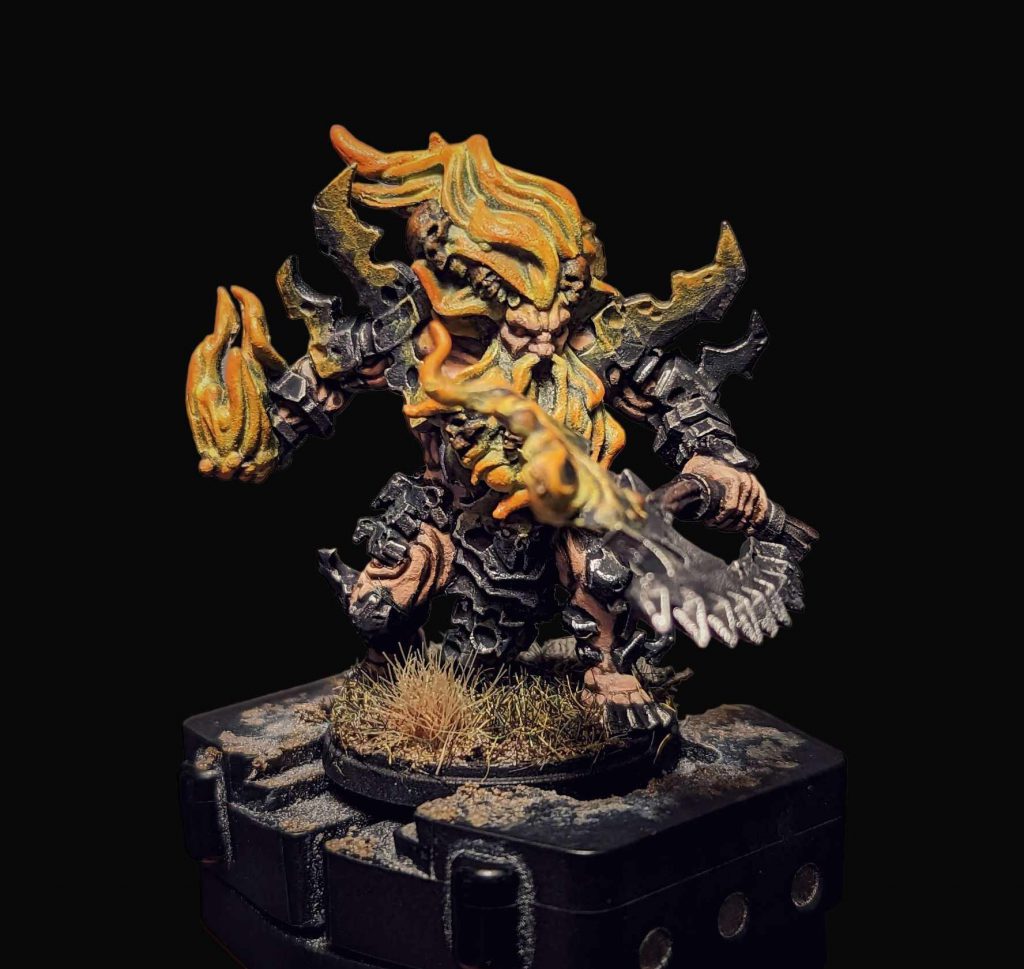
Starter Army – 1,000pts:
== (Warlord) Tempered Sorcerer [160]: Fire School, Focused, Arcane 1, Arcane 2, Arcane 3
* Fireforged (3) [180]:
* Inferno Automata (3) [190]:
== Hold Raegh [110]: Fuelled by the Furnace, Tactical 1
* Hold Ballistae (3) [140]:
* Hold Thanes (3) [220]: Standard Bearer, Herald of Fire
This list takes the Dweghom Starter Box (which by itself will not quite get you to 1,000pts) and adds a Tempered Sorcerer and box of Inferno Automata to make what is quite possibly one of the scariest 1,000pt lists in the game.
In fact, if you’re learning the game with your friends, I would consider dialling back that Tempered Sorcerer, cutting some upgrades and kitbashing a stand of Initiates (which come in the starter box but which we aren’t using here) into an extra stand of Hold Ballistae or something, because that Sorcerer can probably kill much of an opposing 1,000pt army by himself given enough time.
Regardless, this list gives you a nice mix of light, medium and heavy regiments, and is the starting point for a very solid Dweghom collection.
Adding Steelforged – 1,500pts:
== (Warlord) Tempered Sorcerer [160]: Fire School, Focused, Arcane 1, Arcane 2, Arcane 3
* Fireforged (3) [180]:
* Inferno Automata (3) [190]:
== Hold Raegh [110]: Fuelled by the Furnace, Tactical 1
* Hold Thanes (3) [195]: Standard Bearer
* Dragonslayers (3) [230]: Standard Bearer
== Tempered Steelshaper [85]:
* Hold Ballistae (3) [140]:
* Steelforged (3) [210]:
This list takes the starter list listed below and adds in a Steelshaper warband. We’ve moved the Ballistae from the Raegh to the Steelshaper to accommodate us the Steelforged, which I couldn’t not include in a list as soon as we had the points and wherewhithal, and that left us with enough points left over to splash out on a unit of Dragonslayers.
Enter the Hellbringer – 2,000pts:
== (Warlord) Tempered Sorcerer [160]: Fire School, Focused, Arcane 1, Arcane 2, Arcane 3
* Fireforged (3) [180]:
* Inferno Automata (3) [190]:
== Hold Raegh [110]: Fuelled by the Furnace, Tactical 1
* Hold Thanes (4) [250]: Standard Bearer
* Dragonslayers (3) [230]: Standard Bearer
== Tempered Steelshaper [85]:
* Hold Ballistae (3) [140]:
* Steelforged (3) [210]:
== Tempered Sorcerer [125]: Fire School, Hellbringer Sorcerer
* Hellbringer Drake (1) [180]:
* Hold Ballistae (3) [140]:
With our final few purchases to get to 2,000pts, we’ve splashed out on the big kahuna, the Hellbringer Drake with Tempered Sorcerer. A single unit of Hold Ballistae round out the warband, and we’re going to take some spare parts from that Dragonslayers box we bought at 1,500pts and combine them with bodies from a stand of wardens/initiates from the starter box to kitbash a fourth stand for our Hold Thanes (or just spread your Thane or Dragonslayer units out three-troops-a-stand on scenic bases and be polite when asking your TO for forgiveness).
Although this is a nice big flashy way to round out to 2,000pts, there’s plenty of ways you could take this final upgrade. You could add more regiments to your existing warbands, like extra Fireforged and Inferno Automata in the original Sorcerer warband, or straight up duplicate the existing Steelshaper warband for even more Steelforged. Either way, you’re flush with options guaranteed to make you happy and your opponents furiously looking up the rules for the Tempered Creed to make sure it actually really does work that way and yes their elite killer regiment just bounced off your screen and are about to get exploded by fireballs.
As always if you want to get 10% off and support Goonhammer you can make your Conquest purchase by clicking here for US/Canada or here for EU/rest of world. You’ll also need to enter code “goonhammer” at checkout.
Have any questions or feedback? Drop us a note in the comments below or email us at contact@goonhammer.com.



You must be logged in to post a comment.